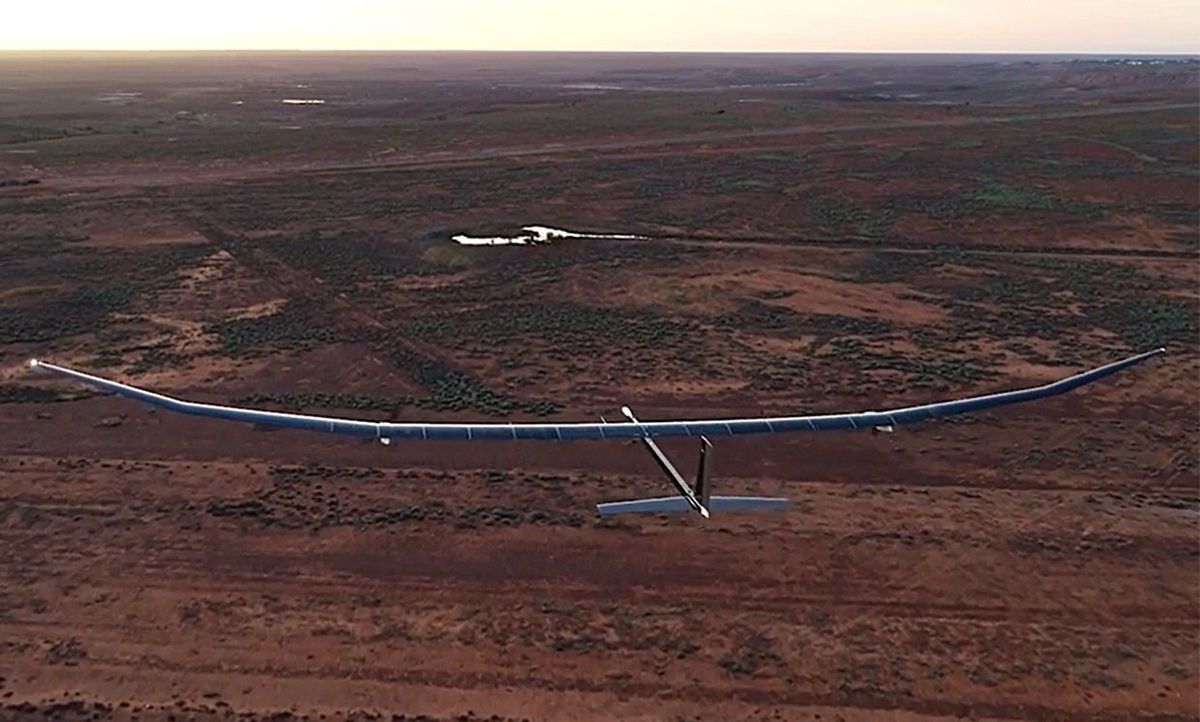At 35 meters, the wingspan of the new BAE Systems aircraft equals that of a Boeing 737, yet the plane weighs in at just 150 kilograms, including a 15 kg payload. The unmanned plane, dubbed the PHASA-35 (Persistent High-Altitude Solar Aircraft), made its maiden voyage on 10 February at the Royal Australian Air Force Woomera Test Range in South Australia.
“It flew for just under an hour—enough time to successfully test its aerodynamics, autopilot system, and maneuverability,” says Phil Varty, business development leader of emerging products at BAE Systems. “We’d previously tested other sub-systems such as the flight control system in smaller models of the plane in the U.K. and Australia, so we’d taken much of the risk out of the craft before the test flight.”
The prototype aircraft uses gallium arsenide–based triple-junction solar cell panels manufactured by MicroLink Devices in Niles, Ill. MicroLink claims an energy conversion efficiency of 31 percent for these specialist panels.
“For test purposes, the solar panels—which are as thin as paper—covered just part of the wingspan to generate 4 kilowatts of power,” says Varty. “For the production version, we’ll use all that space to produce 12 kilowatts.”
The energy is used to drive two brushless, direct-drive electric motors modified for the aircraft, and to charge a lithium-ion battery system comprising over 400 batteries that delivers the energy needed to fly the plane at night. They are supplied by Amprius Technologies in Fremont, Calif.
Varty says that unlike the solar panels, which have been chosen for their high efficiency, the batteries—similar to the kind powering smartphones—are not massively efficient. Instead, they are a proven, reliable technology that can easily be replaced when a more efficient version becomes available.
“Although the test flight took place in Australia’s summer, the aircraft is designed for flying during the worst time of the year—the winter solstice,” says Varty. “That’s why it has the potential to stay up for a whole year in the stratosphere, around 65,000 feet [20,000 meters], where there’s little wind and no clouds or turbulence.”

He describes the unmanned control flight system as a relatively simple design similar to that used in drones and model airplanes. A controller on the ground, known as the pilot, guides the plane, though the aircraft can also run on autopilot using a preprogrammed route. Other technicians may also be involved to control specialist applications such as cameras, surveillance, or communications equipment.
The aircraft was originally developed by Prismatic Ltd., a designer and manufacturer of unmanned aerial vehicles in Southwest England that was acquired last year by BAE.
Further test flights are planned for this year and engineers from Prismatic and BAE are using the results of the trial to improve the various subsystems.
“There were no surprises found during the test flight so perhaps the biggest challenge now is educating the market that what we are offering is different,” says Varty. “Different from satellites or drones.”
Its special feature is it can sit in the stratosphere over a particular point by flying into the wind or doing maneuvers like a figure eight and using cameras or surveillance equipment mounted on gimbals to provide constant monitoring. By comparison, Varty says, even the best military drones can stay airborne for a maximum of only three days; satellites are limited by virtue of the fact that they have to maintain a speed of 7 kilometers per second or more in order to stay in orbit.
“Satellites provide merely a date-time snapshot of what is going on below,” Varty points out. “Whereas we can monitor a spot for as long as necessary to draw conclusions about what is likely to happen next: where forest fires are going to spread, for instance, or where disaster relief is most needed.”
After reviewing the BAE announcement, Saburo Matsunaga, head of the Laboratory for Space Systems at the Tokyo Institute of Technology, sees both pros and cons with the aircraft.
Compared to satellites, its “lower altitude means it should realize higher resolution monitoring, low power communications, dedicated local area services, and so on. But performance, he adds, “will be strongly dependent on the equipment constraints such as mass, volume, and power budget” because the aircraft’s lightweight design limits its payload.
As for possible drawbacks, Matsunaga suspects long-duration operations—which assumes no maintenance and no failures—may be more difficult to achieve and more expensive to deal with that BAE expects. “The flights must always be controlled, and the available time for [issue-free] flights will be short. Communications with the plane’s tracking control and operation systems may also be a concern over long flights. And there’s the possibility that external disturbances may affect sensor resolution.”
BAE plans to offer several different services to customers based on the aircraft’s ability to constantly monitor a particular point or to provide it with communications via onboard transceiver equipment. “A customer could use it to monitor how crops are growing or how minute by minute, hour by hour changes to weather affect areas of interest on the ground,” says Varty. “Now we’re working out the pricing for such services. Direct sales of the aircraft are also possible.”
Commercialization will soon follow completion of the flight trials, which could mean the launch of services as early as next year.



